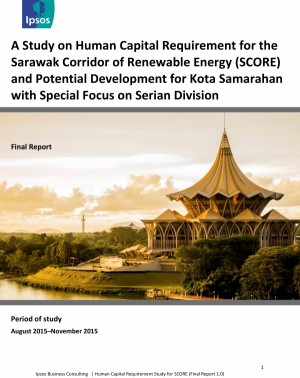A Study on Human Capital Requirement for the Sarawak Corridor of Renewable Energy (SCORE) and Potential Development for Kota Samarahan with Special Focus on Serian Division
As in the other corridor research, this study examined the human capital requirements associated with development and investment efforts focused on five growth regional nodes within SCORE, but also Kota Samarahan. The five nodes are Tanjung Manis, Mukah, Samalaju, Baram and Tunoh, while for Kota Samarahan the focused on Serian district. The study was to identify human capital supply and demand issues for the specified economic sub-sectors within each regional node and outline good practices and strategies which can be adopted from experience elsewhere to enhance the availability and sustainability of talent for SCORE’s development needs. The largest demand appear to be for semi-skilled workers in the industries covered. Employers preferred fresh graduates with some exposure to the industry thus highlighting the importance of internships and other attachments to the workplace for students at academic, TVET and training institutions. Jobs in heavy industries like aluminium, steel and shipbuilding were perceived to be unattractive. In part this relates to issues of access and cost-of-living related to remoteness of the work location. Critical jobs facing high demand or potential shortages include CNC machinist, heavy vehicle mechanics and tour guides. Greater collaboration between industry and educational and training providers needed to have better integrated talent development of relevance to job requirements and skills. With high demand in semi-skills jobs TVET type educations needs to be promoted to reduce perception of career path unattractiveness.
 Bahasa Melayu
Bahasa Melayu  English
English 